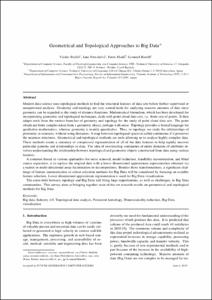Mostra el registre d'ítem simple
Geometrical and topological approaches to big data
| dc.contributor.author | Snasel, Vaclav |
| dc.contributor.author | Nowaková, Jana |
| dc.contributor.author | Xhafa Xhafa, Fatos |
| dc.contributor.author | Barolli, Leonard |
| dc.contributor.other | Universitat Politècnica de Catalunya. Departament de Ciències de la Computació |
| dc.date.accessioned | 2016-09-08T08:03:04Z |
| dc.date.available | 2018-06-29T00:30:18Z |
| dc.date.issued | 2016-06-29 |
| dc.identifier.citation | Snasel, V., Nowaková, J., Xhafa, F., Barolli, L. Geometrical and topological approaches to big data. "Future generation computer systems", Febrer 2017, vol. 67, p.286-296. |
| dc.identifier.issn | 0167-739X |
| dc.identifier.uri | http://hdl.handle.net/2117/89691 |
| dc.description.abstract | Modern data science uses topological methods to find the structural features of data sets before further supervised or unsupervised analysis. Geometry and topology are very natural tools for analysing massive amounts of data since geometry can be regarded as the study of distance functions. Mathematical formalism, which has been developed for incorporating geometric and topological techniques, deals with point cloud data sets, i.e. finite sets of points. It then adapts tools from the various branches of geometry and topology for the study of point cloud data sets. The point clouds are finite samples taken from a geometric object, perhaps with noise. Topology provides a formal language for qualitative mathematics, whereas geometry is mainly quantitative. Thus, in topology, we study the relationships of proximity or nearness, without using distances. A map between topological spaces is called continuous if it preserves the nearness structures. Geometrical and topological methods are tools allowing us to analyse highly complex data. These methods create a summary or compressed representation of all of the data features to help to rapidly uncover particular patterns and relationships in data. The idea of constructing summaries of entire domains of attributes involves understanding the relationship between topological and geometric objects constructed from data using various features. A common thread in various approaches for noise removal, model reduction, feasibility reconstruction, and blind source separation, is to replace the original data with a lower dimensional approximate representation obtained via a matrix or multi-directional array factorization or decomposition. Besides those transformations, a significant challenge of feature summarization or subset selection methods for Big Data will be considered by focusing on scalable feature selection. Lower dimensional approximate representation is used for Big Data visualization. The cross-field between topology and Big Data will bring huge opportunities, as well as challenges, to Big Data communities. This survey aims at bringing together state-of-the-art research results on geometrical and topological methods for Big Data. |
| dc.format.extent | 11 p. |
| dc.language.iso | eng |
| dc.publisher | Elsevier |
| dc.rights.uri | http://creativecommons.org/licenses/by-nc-nd/3.0/es/ |
| dc.subject | Àrees temàtiques de la UPC::Informàtica::Sistemes d'informació::Emmagatzematge i recuperació de la informació |
| dc.subject.lcsh | Big data |
| dc.subject.other | Big data |
| dc.subject.other | Industry 4.0 |
| dc.subject.other | Topological data analysis |
| dc.subject.other | Persistent homology |
| dc.subject.other | Dimensionality reduction |
| dc.subject.other | Big data visualization |
| dc.title | Geometrical and topological approaches to big data |
| dc.type | Article |
| dc.subject.lemac | Macrodades |
| dc.identifier.doi | 10.1016/j.future.2016.06.005 |
| dc.description.peerreviewed | Peer Reviewed |
| dc.relation.publisherversion | http://www.sciencedirect.com/science/article/pii/S0167739X16301856 |
| dc.rights.access | Open Access |
| local.identifier.drac | 18550370 |
| dc.description.version | Postprint (author's final draft) |
| local.citation.author | Snasel, V.; Nowaková, J.; Xhafa, F.; Barolli, L. |
| local.citation.publicationName | Future generation computer systems |
| local.citation.volume | 67 |
| local.citation.startingPage | 286 |
| local.citation.endingPage | 296 |
Fitxers d'aquest items
Aquest ítem apareix a les col·leccions següents
-
Articles de revista [1.049]


